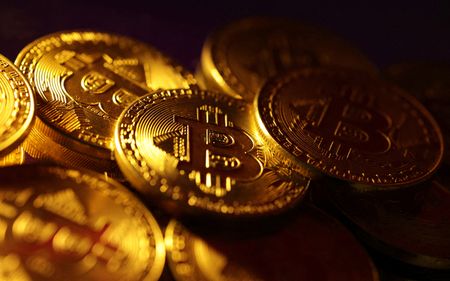(Reuters) – Concern about the rapidly rising U.S. government debt is partly behind recent surges in gold prices and bitcoin, even as the Treasury market so far remains relatively sanguine about the country’s fiscal path, market observers say.
The U.S. budget deficit widened to $1.7 trillion in fiscal year 2023 and is on track to reach $2.6 trillion by 2034, according to the Congressional Budget Office. U.S. government debt held by the public, meanwhile, is on pace to reach a record 106% of gross domestic product (GDP) in 2028, up from 97% in fiscal year 2023. It has soared to $27 trillion from $17 trillion in early 2020 and $5 trillion in 2007.
The unchecked growth of U.S. government debt is gaining more attention as interest rate payments also take a larger bite of the government’s budget – in some months exceeding spending on national defense.
This worsening trajectory has boosted demand for bitcoin and gold, which are often used as a hedge against inflation and the depreciating purchasing power of the U.S. currency.
“Concerns about the U.S. debt cycle, devaluation of money – and fiat money in particular – does drive the story and the narrative,” said Brad Bechtel, global head of FX at Jefferies.
That “at the margin pushes investors to allocate more towards something like (bitcoin) than they otherwise would,” and for gold “it’s even bigger there,” Bechtel said. “Concerns about debasing of fiat money is generally one of the drivers of the gold bugs.
Yields in Treasury debt largely reflect expectations of Federal Reserve interest rate policy. At times they are swayed by increases in debt supply, though the longer-term fiscal trajectory is less of a factor in the market.
The U.S. central bank has intermittently purchased Treasuries in an effort to stimulate growth, which can pull yields lower and increase the supply of dollars.
Supply disruptions, record government spending and ultra loose monetary policy as businesses were shut down for Covid in 2020 led to soaring prices pressures that have still not completely abated.
“There’s interest in both gold and bitcoin because of that, because inflation’s been unsteady in the last couple of years,” said Lawrence H. White, professor of economics at George Mason Univer
sity.
More concerning is that the rising debt and deficit “is in peace time with an economy that’s running at full employment… that’s normally when you should be running surpluses and we’re not even close,” White said. “So, in the next recession we’re going to have an even bigger jump up in debt.”
Certainly there are other major factors driving the interest in bitcoin and gold.
Bitcoin has been buoyed by new exchange-traded funds (ETFs) that invest in the cryptocurrency, drawing in more investors. It is also approaching a halving, when the rewards from mining bitcoin are cut by 50%.
That has traditionally been bullish for bitcoin, said Bechtel. Bitcoin reached a record $73,803 in March.
The gold surge is also being driven by expectations of central bank rate cuts and purchases by foreign central banks diversifying their reserves. This is partly due to inflation concerns, and also a way to protect against possible U.S. sanctions in a geopolitical dispute.
Gold hit a record $2,431 per ounce last week.
But the rapidly worsening U.S. fiscal situation remains a key driver for some investors.
Michael Hartnett, investment strategist at Bank of America, said in a recent report that recent highs in gold and tech stocks are indicating that the “parlous state of US govt finances” will inevitably lead to policies including yield curve control “to prevent (a) debt crisis.”
In yield curve control a central bank buys bonds in order to maintain a target interest rate, which can reduce government borrowing costs.
So far, however, several Treasury market indicators show that bonds are not pricing in a worsening fiscal outlook, said Nicholas Colas, co-founder of DataTrek Research.
These include 10-year Treasury yields trading well below those on three-month notes. Real 10-year yields, which “reflect all risks other than future inflation,” are also around the same level as from 2003–2007, when the debt to GDP ratio was half of what it is now.
Treasury investors “still see the dollar as the reserve currency, they still see Treasuries as relatively safe and there’s enough Treasuries out there to put money to work,” Colas said. “If you’re looking for risk free assets in size the Treasury market’s still the place to go.”
(Reporting By Karen Brettell; Editing by Alden Bentley and Chizu Nomiyama)





